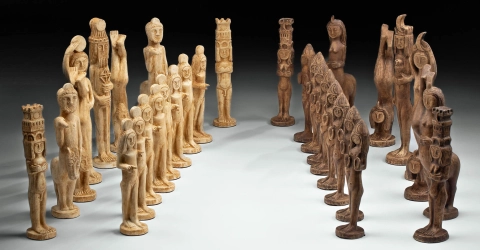Chess Set, c.1950
Description
Anton Prinner (Franco-Hungarian, 1902-1983). Ceramic chess set, ca. 1950. A rare and complete ceramic chess set by transgender modernist Anton Prinner, with all 32 pieces, 11 of which are marked Prinner or Vallauris on the base. Kings, Queens, Bishops, Rooks, Knights, and Pawns present with playful poses, Egyptian iconography as Prinner had a passion for ancient Egypt, and nude bodies, most with visible genitalia. Interestingly, gender identification played a major role in Prinner's life. In 1902, he was born female in Budapest; however, near the end of the Roaring Twenties, Prinner immigrated to Paris where he changed his name from Anna to Anton, cross dressed, and used male pronouns. Prinner thrived as an artist in progressive Paris - making friends among the avant-garde including Pablo Picasso who endearingly addressed Prinner as "Monsieur Madame" - and also exploring "themes of androgyny and metamorphosis" in his sculptures. Sizes range from 19 cm for the pawns to 27.6 cm for the kings.
About the artist: "Printmaker, sculptor and ceramicist; Anton Prinner was born Antonia Prinner until changing name and sex at an unknown date; trained at the School of Fine Arts, Budapest and then left Hungary to settle in Paris in 1928; from 1930 started making unorthodox prints by a technique Prinner called 'papyrogravures' from cut-out cardboard shapes glued on a sheet of paper which were then covered with varnish and inked with a roller; other elements, such as string or roundels of paper, were simply placed on the matrix and removed after inking, leaving a silhouette in white on the printed sheet; from 1932 Prinner made engravings at Atelier 17 with S.W. Hayter which revealed Surrealist and Constructivist influences; at this time became friends with the Surrealists Prevert, Andre Breton and Vieira da Silva and developed lifelong interest in Egyptian philosophy and the occult sciences; began making sculpture from 1937; exhibited in Paris at Galerie Jeanne Bucher in 1942 and at Pierre Loeb in 1945; produced a suite of eight engravings and etchings for self-published book 'La Femme tondue' (1945) and made a series of 66 etched and engraved illustrations for the 'Livre des morts des anciens Egyptiens' (shown at Pierre Loeb in 1948); from 1950 worked in sculpture and ceramics, sometimes on a monumental scale, at Vallauris until 1965; died in obscurity in 1983." (British Museum)
Victoria and Albert Museum blog entry about Prinner: "Last week I was excited to discover a transgender artist in the collection called Anton Prinner. Born in Hungary in 1902, he moved to Paris at the end of the Roaring Twenties, where he changed his name to Anton and requested that people address him with male pronouns. Paris at the time was the epicentre of the avant-garde and was considered highly progressive, a haven for the open-minded, and full to bursting with many of the world's greatest artists and writers.
Prinner quickly fell in with groups of other artistic emigres living in the Montparnasse area, such as fellow Hungarian Arpad Szenes, Portuguese artist Maria Vieira da Silva, and Hackney born print-maker Stanley William Hayter. He also befriended the founder of Surrealism, Andre Breton, and France most popular 20th century poet, Jacques Prevert.
The artist Pablo Picasso would address Prinner as 'Monsieur Madame' and would often introduce him to others as 'the small man who makes large statues'. Although the former term would largely be considered insulting by today's standards, Prinner and Picasso were great friends and by all accounts it appears that Prinner was wholly accepted in the circles he moved in. Indeed it seems he was never drawn into having public discussions about his gender identity at any point in his lifetime. Spending much of the German occupation of Paris in hiding, he later settled near Picasso's studio in Antibes in the south of France in 1950, where his work became progressively esoteric and several of his sculptures explored themes of androgyny and metamorphosis. Returning to Paris in the mid-1960s, he replaced sculpture with painting and continued to have the occasional small exhibition in the city. His enduring popularity within the art scene is demonstrated by accounts that in the 1960s he had his own table at the famous Montparnasse cafe, La Coupole, where apparently he would have a burger every night and hold court with different groups of artists and local bohemians.
Whilst he is quite widely collected in France, he essentially never achieved great fame or financial success in his lifetime and sadly died in poverty at the age of 81 in his beloved Paris.







